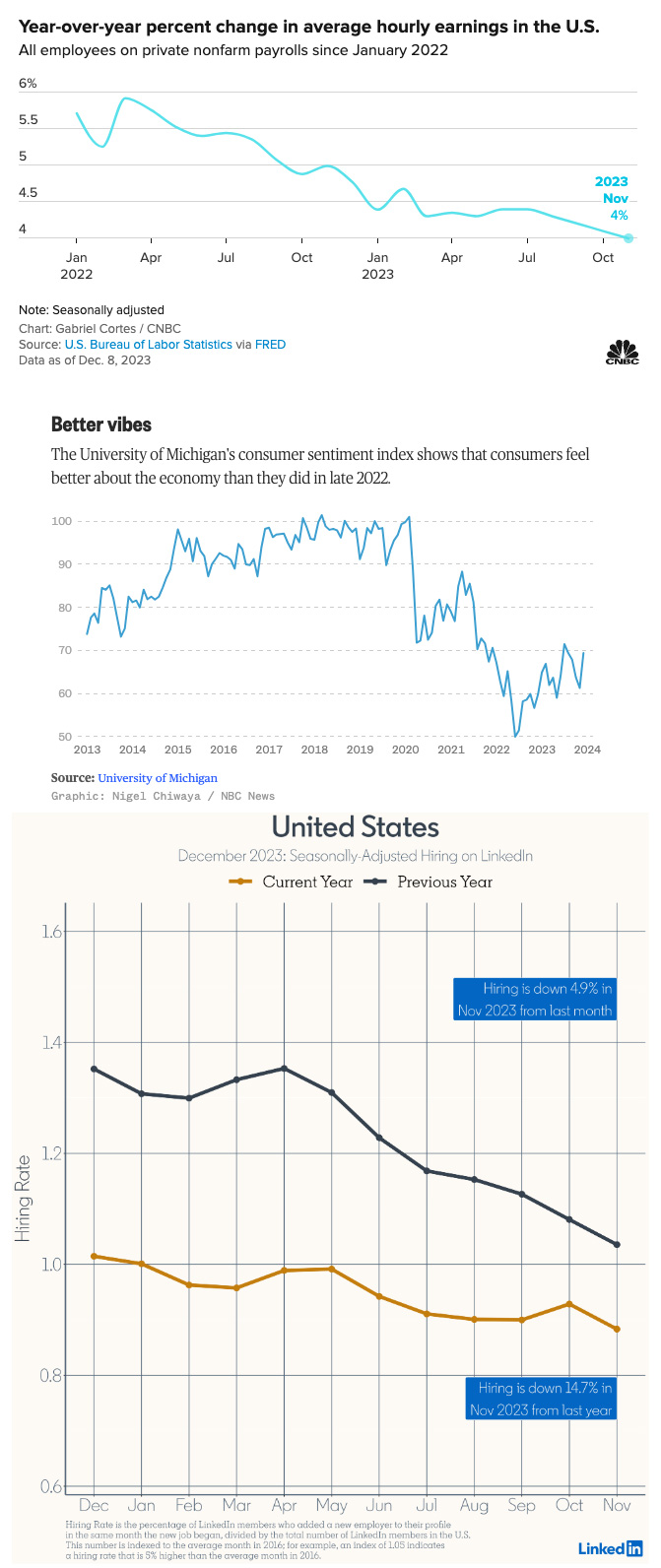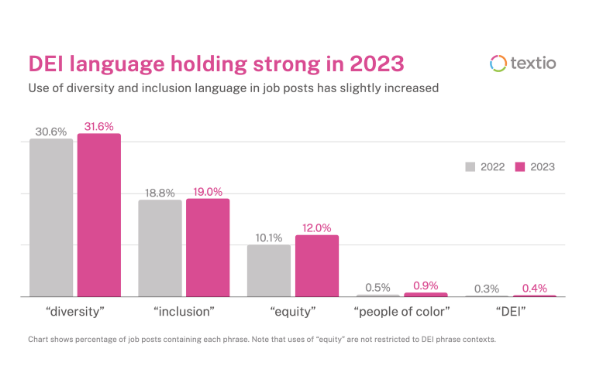Economic Update: Dcember 2023
Change State Friends
Our team wishes you a happy and bright holiday season. Whatever you celebrate, we hope you have much joy this month as you gather with family and friends. As 2023 comes to a close, what is your approach to reflecting on the year past? Do you have resolutions you’ve successfully ticked off, or are you planning to try them again next year? Truthfully, I’m not much of a resolution person…I find I gravitate more towards yearly “themes”. This year’s focus was on slowing things down and being more deliberate about how I spend my time. I don’t have a theme yet for next year, but if you’re like me and in need of some inspiration, how about a collection of 34 big ideas that will change the world in 2024? And finally, just because I’m curious…Pantone’s new color of the year is, well, rather polarizing (I’ve seen it described more than once as “raw chicken pink”). What do you think, love it or hate it? Write and let me know.
Happy New Year and we will see you again in 2024!
Cheers, 
Nicole

Economic Snapshot
Employment rose by 199,000 in November, just a tick above Wall Street’s estimate; the market continues to pull more workers off the sidelines each month. The divergence between the household and establishment surveys in October appears to have been a temporary aberration, and the household survey is now back in step. Last Friday’s report showed a decline in unemployment from 3.9% to 3.7%, which has remained under 4% for nearly two years, a feat not achieved since the late 1960s. With unemployment dropping, prime-age employment rate rose to 80.7%. EPOP rebounded for prime-age men in November, rising to 86.3% while the women’s decreased from an all-time high to 75.1%. The number of Americans participating in the labor force (62.8%) is at the highest point since the pandemic. Still, it remains below its pre-COVID levels, largely due to the advancing retirement of baby boomers.
Nearly all of the job growth in November came from just three sectors: health care (77,000), government employment (49,000), and leisure and hospitality (40,000). November’s job gains were boosted by the end of strikes in Hollywood and the automotive industry, and manufacturing in particular saw an increase of 28,000 from the prior month. Notably, retail had a marked setback in November, posting a loss of 38,000 jobs – a somewhat somber omen for the close of the holiday shopping season. This year has been the slowest for seasonal hiring announcements since a decade ago, according to employment firm Challenger, Gray & Christmas.
The latest jobs report showcases a labor market that is gradually moving into lower gear. Employers continue hiring but are less desperate to fill huge numbers of jobs. While some sectors saw gains last month, overall hiring moderated in November: according to LinkedIn’s measure, hiring is down 4.9% in November 2023 as compared to October 2023. While the labor market is still stabilizing, the tapering has been slow, with hiring down just 3.1% since July.
Meanwhile, job openings have dropped considerably from the peak of 12 million in March 2022 to 8.7 million jobs in October – clearly, employers are no longer in a hiring hysteria. The low layoff rate is a sign that employers are contining to hoard workers despite diminished demand, a holdover from intense competition during the pandemic. A report earlier in the month showed slightly more US workers applied for unemployment benefits, though experts suggest that the number is not cause for alarm. “The job market continues to be resilient after a year of dodging recession fears,” noted Daniel Zhao, lead economist at Glassdoor. “Really the one concern that we had coming in today’s report was the recent rise in the unemployment rate. So the improvement in unemployment was a welcome relief.”
Inflation has plunged from a high of 9.1% in June 2022 to 3.2% last month. Moreover, wage growth slackened in November, rising by 4 % over the year to $34.10 an hour. That is good news for workers: as wage growth and inflation have tempered, earnings are now beating price increases, boosting American spending power. “This is encouraging for central bankers and the people getting real wage gains,” Nick Bunker, economic research director at Indeed agreed. “It’s helping people spend more which is good for GDP growth and for everyone. It’s a win-win for a variety of audiences.”
And truly, the American consumer is the key to the economy – collectively accounting for nearly 70% of all US economic activity. By many factors, they’ve held up fairly well: consumer alarm about rising prices appears to be receding, with the University of Michigan’s consumer sentiment index rising in December by 13% to 69.4, as people became less concerned about inflation and favoring a rosier outlook on other issues. The report surprised experts, as economists surveyed by Dow Jones and The Wall Street Journal thought sentiment would only inch higher to 62.4 (from last month’s 61.3). Of course, mixed signals are still coming from consumers as noted by The Conference Board and Deloitte – no doubt fueled in part by the fact that consumer debt in the US is at an all-time high. Some have suggested not to put too much stock in confidence indices at the risk of overlooking greater signals. Therefore, the current outlook may be more accurately described as a “rolling recession”: market contractions could affect certain facets of the economy without dragging every sector down along with them.
Lastly, there was another tidbit of positive inflationary news on Friday: rental costs declined 0.57% in November and were down 2.1% year over year, which makes November the first time in more than 3.5 years that year-over-year prices declined by more than a percent, according to Rent.com. “The overall picture is one of a solid labor market that is slowing gradually, not falling off a cliff,” remarked Julia Pollak, chief economist at ZipRecruiter. “The breadth of job gains is all in health care and government. The rest of the economy has ground to a halt. That’s the effect of high interest rates.”

So far, anticipation is growing around the Fed’s chances at sticking the landing. With inflation easing, expectations are increasingly centered around the officials pivoting strategy and cutting interest rates next year.
Presumably, this week will mark the third straight time that its officials have kept the rate steady, adding credibility to assumptions that the two-year hiking campaign is now over. Less clear, however, is when exactly cuts will take place. Christopher Waller, a key Fed official who typically favors a conservative approach, recently raised the possibility that if inflation kept falling, the Fed could cut rates as early as spring. But in the absence of robust cooldown data, Wall Street is now betting on a less than a 46% chance we will see a rate cut by March. Interestingly, this represents a significant drop from the 65% prediction on the day prior to the jobs report. Clearly the strength in November’s data could suggest the central bank needs to maintain peak rates for a longer period. Nancy Vanden Houten, lead economist at Oxford Economics, doesn’t expect the first rate cut until after the summer: “Financial markets have gotten pretty ahead of themselves in our view. We think rate hikes are done, but it’s going to be many months before the Fed starts cutting rates.”
But what if being patient isn’t exactly a problem? Guy Berger, former principal economist at LinkedIn, said the job market’s tenacity suggests the Fed can continue existing rates to fight inflation without overdoing it: “If we’re not cooling, what’s the rush?”. Jim Bullard, former president of the Federal Reserve Bank of St. Louis, agreed: “Why lower the policy rate if the real economy is doing just fine?[…] You might as well just sit back and enjoy the disinflation.”
If we must play the waiting game, at least a soft landing seems increasingly within our grasp. Such a significant reduction in inflation without simultaneous recession or job losses, is “historically unprecedented,” as economists at Goldman Sachs wrote in a recent note. Austan Goolsbee, the Chicago Fed president, said in an interview last month that the US is on track this year for the fastest annual drop in inflation on record. If so, Goolsbee said, the result could be a “bigger soft landing than conventional wisdom believes has ever been possible.”
We’ll find out more on where policymaker’s heads are at when they adjourn tomorrow’s meeting.
“The key uncertainty for the labor market in 2024 is whether job growth slows to a more sustainable pace, or whether the economy moves from monthly job gains to monthly job losses. The former would be consistent with the Fed’s soft-landing scenario, while the latter would mean recession […] PNC still thinks recession is the more likely outcome in 2024, but it is a close call.”
(Sources: Economic Policy Institute, The Washington Post, Worldwide ERC, Axios, Barrons, Challenger, Gray & Christmas, AP News, LinkedIn, Reuters, CNBC, MSN, The Fiscal Times, University of Michigan, NBC News, The Conference Board, Deloitte, Statista.com, Business Wire, Rent.com,Yahoo Finance, PBS.org)
What else?

What Else for December?
- X (née Twitter) commentary on the November jobs report from the EPI here.
- Just in time for the holidays, some good news about investments in DEI. While media coverage of DEI initiatives increased by 383% last year, much of that coverage centered on negative backlash. While it may seem DEI advancements are hitting a setback, in fact the opposite may be true. Textio recently found that DEI language in job postings actually increased in 2023. Read more here.
- Burnout is all too common, and 28% of employees say they experience it very often or always. Gallup’s State of the Global Workplace: 2023 Report highlights this issue and examines employees who are thriving despite workplace stress being at an all-time high.
- Perhaps a timely read: higher base pay helps attract talent but may also create equity problems. Check out a new whitepaper from Gartner on how to fill competitive roles without breaking pay guidelines.
- An estimated 30% to 40% of neurodivergent adults are currently unemployed, a major source of untapped talent. Read more on how the community college system can be a uniquely valuable talent pipeline to increase cognitive diversity in the workplace.
- What do the three most Googled jobs in 2023 have in common? None of them require a college degree.
- While much has been made about increasing wages in the last couple of years, for many households the overall gain may be negligible as employers are increasingly cutting back benefits to fund said pay increases.
- Feeling “tired, drowsy, and fed up” after being on video conferencing calls all day? You’re not alone – a (small) new research study corroborates that there is, in fact, a physical toll to all that Zoom-ing.
- Love a good chip but worried about your microphone busting you for snacking during those endless Zoom calls? Well you are in luck – Doritos has a software solution for that.
(Sources: Economic Policy Institute, Textio, Gallup, MITSloan Management Review, CNBC, USA Today, The Washington Post)
